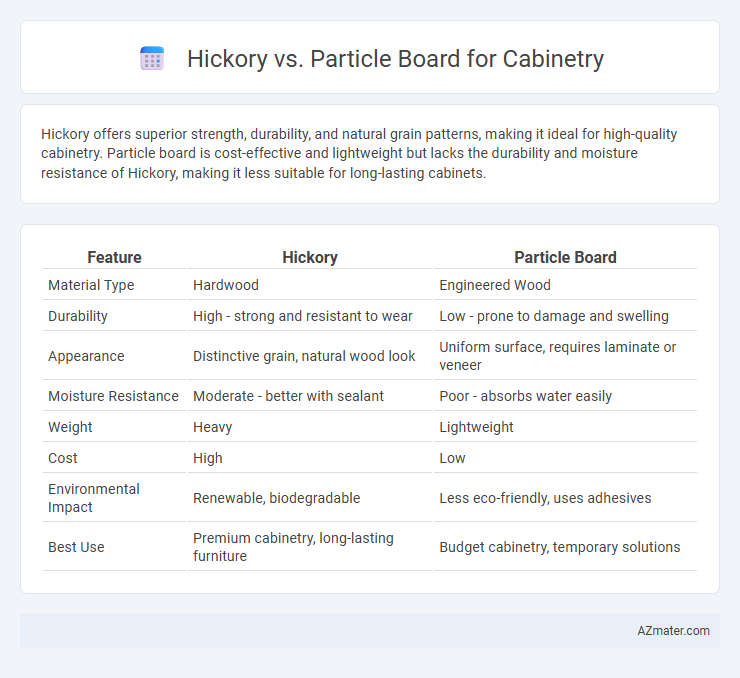Hickory offers superior strength, durability, and natural grain patterns, making it ideal for high-quality cabinetry. Particle board is cost-effective and lightweight but lacks the durability and moisture resistance of Hickory, making it less suitable for long-lasting cabinets.
Table of Comparison
| Feature | Hickory | Particle Board |
|---|---|---|
| Material Type | Hardwood | Engineered Wood |
| Durability | High - strong and resistant to wear | Low - prone to damage and swelling |
| Appearance | Distinctive grain, natural wood look | Uniform surface, requires laminate or veneer |
| Moisture Resistance | Moderate - better with sealant | Poor - absorbs water easily |
| Weight | Heavy | Lightweight |
| Cost | High | Low |
| Environmental Impact | Renewable, biodegradable | Less eco-friendly, uses adhesives |
| Best Use | Premium cabinetry, long-lasting furniture | Budget cabinetry, temporary solutions |
Introduction: Hickory vs Particle Board for Cabinetry
Hickory offers exceptional durability and a distinctive grain pattern, making it a premium choice for cabinetry that demands both strength and aesthetic appeal. Particle board, composed of wood chips and resin, provides an affordable and lightweight alternative but lacks the resilience and natural beauty of solid wood like hickory. When selecting cabinetry materials, understanding the differences in lifespan, maintenance, and visual impact between hickory and particle board is crucial for informed decision-making.
Material Composition and Characteristics
Hickory is a hardwood known for its dense grain, durability, and natural resistance to wear, making it ideal for high-quality cabinetry that requires strength and longevity. Particle board is composed of wood chips, sawdust, and resin, offering a cost-effective and lightweight option but with lower durability and susceptibility to moisture damage. The natural grain patterns and hardness of hickory provide superior aesthetics and structural integrity compared to the uniform, less resilient surface of particle board.
Durability and Strength Comparison
Hickory offers superior durability and strength compared to particle board, making it ideal for cabinetry that requires long-lasting performance. Its dense, hardwood construction resists dents, scratches, and warping, whereas particle board is prone to swelling and damage when exposed to moisture. Hickory cabinets maintain structural integrity over time, ensuring robust support for heavy items, unlike particle board which may weaken and degrade faster under stress.
Aesthetic Appeal and Design Versatility
Hickory offers a rich, natural grain and warm tones that enhance cabinetry with a rustic yet sophisticated aesthetic, making it ideal for traditional and modern designs. Particle board provides a smooth, uniform surface that can be easily laminated or painted, allowing for versatile styles and budget-friendly customization. Hickory's unique patterns create visually striking cabinets, while particle board supports diverse finishes for contemporary aesthetics.
Cost Analysis and Budget Considerations
Hickory cabinets typically cost three to five times more than particle board options due to the high-quality, durable hardwood material. Particle board offers a budget-friendly choice, costing around $20 to $30 per sheet, making it ideal for cost-conscious projects but with lower durability and longevity. Evaluating long-term value, Hickory's resistance to wear and aesthetic appeal may justify the upfront investment compared to the frequent replacement or repair needs associated with particle board cabinetry.
Environmental Impact and Sustainability
Hickory is a hardwood known for its durability and longevity, making it a sustainable choice for cabinetry due to its ability to last generations without replacement, thereby reducing resource consumption over time. Particle board, typically made from wood chips and resin, often incorporates recycled materials but has a shorter lifespan and releases volatile organic compounds (VOCs), negatively impacting indoor air quality and environmental health. Choosing hickory supports sustainable forestry practices when sourced responsibly, whereas particle board's environmental benefits depend heavily on the recyclability of its components and the adhesives used in its production.
Maintenance and Longevity
Hickory cabinets offer superior durability and resistance to wear, requiring minimal maintenance such as occasional cleaning and periodic resealing to preserve their natural finish. Particle board, commonly used in budget cabinetry, tends to absorb moisture, leading to swelling and deterioration over time, which necessitates careful maintenance and timely repairs to extend its lifespan. The longevity of hickory wood cabinets significantly surpasses particle board, making it a more cost-effective choice for long-term investment despite higher upfront costs.
Installation Process and Workability
Hickory offers superior workability for cabinetry due to its dense grain structure, allowing for easy sanding, staining, and precise joinery during installation. Particle board, while lighter and more cost-effective, presents challenges in workability as it tends to chip or crumble under stress, requiring careful handling and specialized fasteners during assembly. Installation with hickory demands standard woodworking tools but results in a durable, stable cabinet, whereas particle board necessitates additional reinforcement and careful moisture protection to ensure longevity.
Common Applications in Cabinetry
Hickory is commonly used in cabinetry for high-end kitchen and furniture projects due to its exceptional hardness, durability, and attractive grain patterns that provide a rustic or traditional aesthetic. Particle board is frequently chosen for budget-friendly cabinetry, especially in interiors like closets or utility rooms, because of its affordability and ease of machining, though it requires proper sealing to resist moisture. Both materials serve distinct roles where hickory offers longevity and visual appeal, while particle board provides economical solutions for less demanding applications.
Final Verdict: Choosing the Right Material
Hickory offers superior durability, distinct grain patterns, and a natural resistance to wear, making it an ideal choice for high-quality cabinetry with a long lifespan. Particle board is more cost-effective and lightweight but lacks the strength and moisture resistance of hardwoods like hickory, often resulting in quicker wear and limited structural integrity. For cabinetry requiring longevity and a premium finish, hickory is recommended, while particle board suits budget-conscious projects or short-term applications.

Infographic: Hickory vs Particle Board for Cabinetry
 azmater.com
azmater.com